
Your Guide to Choosing the Right RFID Hardware
For businesses aiming to boost efficiency, whether it’s through better inventory management, enhanced access control, or precise asset tracking, RFID (Radio Frequency Identification) technology offers a powerful solution. But with a plethora of options available, pinpointing the perfect RFID hardware can feel like navigating a maze.
This guide is designed to simplify that process. We’ll break down the essential factors to consider when selecting RFID hardware. We’ll delve into the different types of RFID tags for sale, RFID readers to buy, and antennas, providing you with the knowledge to seamlessly integrate RFID technology into your operations and potentially explore NFC solutions where relevant.
1. Decoding the Core Components of RFID Hardware
RFID operates as a wireless automatic identification technology, using radio waves to transmit data for identifying, tracking, and managing items. A typical RFID system revolves around these key components:
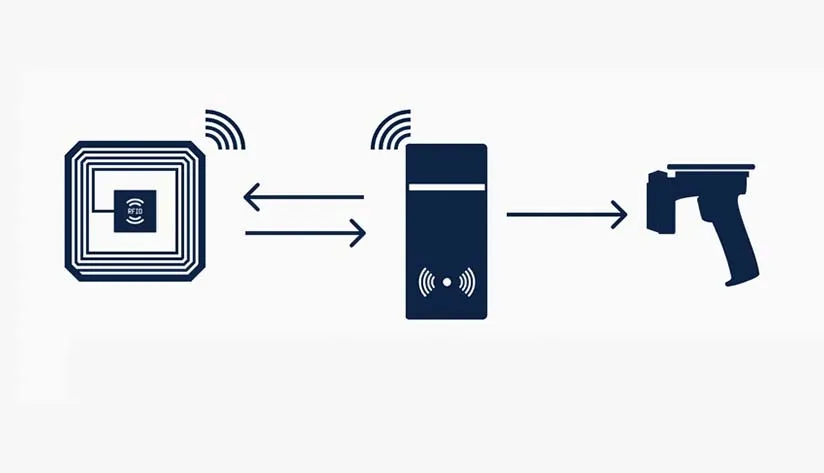
RFID Tags: These are electronic labels attached to items. They store data and communicate wirelessly with the reader. Tags can be passive (powered by the reader’s signal), active (with their own power source), or semi-passive. You can **find RFID tags** in various forms to suit different needs.
RFID Readers: These devices are used to capture data from the tags. They come in several types: fixed readers (mounted in a stationary location), handheld readers (portable for manual use), and integrated readers (built into other equipment). If you’re looking to **purchase RFID readers**, consider the specific requirements of your application.
Antenna: The antenna is crucial for sending radio frequency signals to the tags and receiving the data they transmit back. Antennas vary in form and size depending on the specific application.
Software System: This component processes and manages the data received from the readers, integrating it with other business systems like inventory management and access control.
When an RFID tag comes within the reader’s range, the reader sends out a radio frequency signal via the antenna. This signal prompts the tag’s internal chip to respond and transmit its stored data. The software system then processes this data for further action.
2. Key Considerations for Choosing Your RFID Hardware
Selecting the right RFID hardware goes beyond just buying tags and readers. It involves carefully evaluating several critical factors, including your specific application, the environment where the hardware will be used, and your performance requirements. Businesses need to thoroughly consider these aspects to ensure the RFID system effectively meets their operational needs and provides the best return on investment.
2.1 Use Case & Application
Different applications have unique demands for RFID hardware. Here are some common RFID applications and their key considerations:
Inventory and Asset Management
- Key Requirements: Durability, read range, tag storage capacity.
- Recommended Hardware: Durable passive RFID tags (like UHF tags) and fixed or handheld RFID readers.
Access Control
- Key Requirements: Security, encrypted communication, rapid response.
- Recommended Hardware: RFID access cards and high-security encrypted readers (such as MIFARE DESFire or HID iCLASS).
Supply Chain & Logistics
- Key Requirements: Long-distance reading, anti-interference, durability.
- Recommended Hardware: Ultra-high frequency (UHF) passive tags.
2.2 Environment & Durability
The environment where your RFID hardware will operate directly impacts its performance and longevity. Therefore, it’s vital to consider these factors when making your selection:
Indoor vs. Outdoor Use
- Indoor Environments: Typically require readers and tags with high accuracy and reliability, with relatively lower demands for extreme durability.
- Outdoor Environments: Need to withstand waterproofing, dust, and extreme temperatures, as found in external warehouses, construction sites, or open parking lots.
- Recommended Hardware: Waterproof encapsulated RFID tags (like IP68 rated industrial tags) and weather-resistant RFID readers.
Material Compatibility
- Different materials can affect how RFID signals travel. Ensure your RFID tags are suitable for the surfaces they’ll be attached to:
- Metal Surfaces: Metal reflects RF signals, so specialized anti-metal RFID tags are necessary.
- Plastic/Glass/Wood: Most standard RFID tags perform well on these materials.
- Recommended Hardware: Anti-metal RFID tags, flexible tags (for curved surfaces).
2.3 Performance Requirements
Read Range
- The required reading range for your RFID hardware will vary depending on your application:
- Short Distance (a few centimeters to 1 meter): Suitable for access control and payment systems (like hotel key cards and transit passes).
- Medium Distance (1-10 meters): Ideal for warehouse management and item tracking (such as inventory management in clothing retail).
- Long Distance (over 10 meters): Used for supply chain tracking and vehicle management (like highway tolling or logistics tracking).
- Recommended Hardware: Near field communication (NFC) tags, UHF tags, remote active RFID tags.
Speed and Efficiency
- In some applications, reading speed is critical:
- High Throughput Environments: Such as airport baggage handling or automated warehouse sorting, require rapid reading of multiple tags.
- Single Scan Environments: Like access control systems, where quickly reading a single tag is sufficient.
- Recommended Hardware: Multi-channel high-frequency readers (for bulk reading) and fast-response RFID tags (for applications needing immediate responses).
By carefully considering these key factors, businesses can select the ideal RFID hardware tailored to their specific needs, ultimately boosting operational efficiency and ensuring the system’s effectiveness.
3. How to Choose the Right RFID Tags
Selecting the appropriate RFID tags is crucial for the system’s reading effectiveness, overall reliability, and durability. When choosing tags, consider factors like size, operating frequency, and attachment methods to ensure they perfectly fit your application.
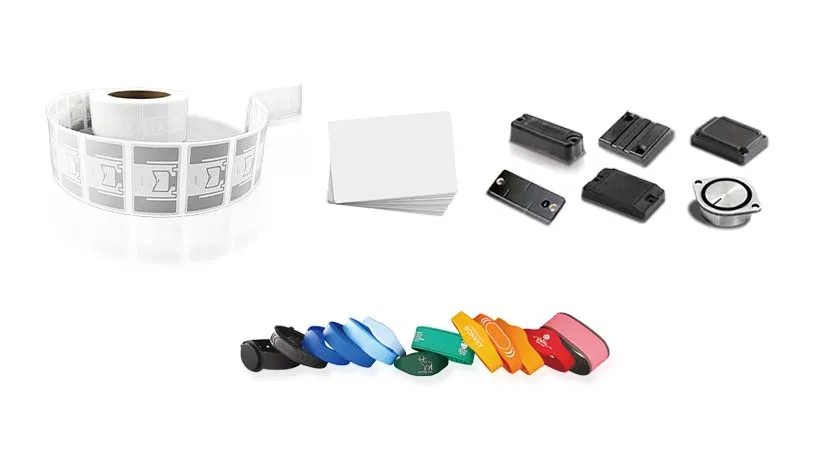
3.1 Size and Form Factor
The size and shape of RFID tags should match the physical characteristics of the assets they’ll be attached to. This ensures they don’t interfere with usability while providing reliable reading. Common tag types include:
Small & Flexible Labels: Suitable for items like clothing, pharmaceuticals, or small electronics, such as garment hang tags and medical packaging labels.
Custom Tags: Designed for industrial equipment, logistics pallets, and other demanding scenarios. These tags can withstand high temperatures and shocks, making them ideal for asset tracking.
Embedded Tags: Can be integrated directly into products, perfect for tracking automotive parts or tools to prevent loss or tampering.
3.2 Frequency
The operating frequency of RFID tags determines their read range and the environments where they can be used. Different regions have regulations on RFID frequencies, making it crucial to select the appropriate one.
| Frequency | Read Range | Applicable Scenarios | Key Features |
| Low Frequency (LF, 125-134 kHz) | Up to 10 cm | Animal identification, access control | Strong anti-interference, but short read range |
| High Frequency (HF, 13.56 MHz) | 10 cm – 1 m | Electronic payments, ticketing, access control | Suitable for short-distance, high-security applications like NFC |
| Ultra High Frequency (UHF, 860-960 MHz) | 1-15 m | Supply chain, logistics, warehousing | Long-distance reading, ideal for large-scale asset management |
3.3 Attachment Methods
Depending on the application, various methods are available for attaching RFID tags to ensure optimal reading performance and durability:
Adhesive-backed Tags:
- Applicable Scenarios: Cardboard boxes, clothing tags, electronic product packaging.
- Advantages: Easy to apply and suitable for one-time or short-term use.
Hard Plastic Tags:
- Applicable Scenarios: Industrial equipment, tools, logistics pallets.
- Advantages: Shock-resistant, waterproof, and dustproof, making them suitable for harsh environments.
3.4 Special Tags for Challenging Environments
Certain challenging environments require specially designed RFID tags:
On-Metal Tags: Equipped with a special shielding layer to prevent RF signal disruption by metal. Ideal for automotive manufacturing or equipment management.
Heat-Resistant Tags: Suitable for high-temperature environments in manufacturing, like paint production lines or engine components.
Chemical-Resistant Tags: Used in medical, laboratory, and food industries, capable of withstanding exposure to disinfectants or chemical substances.
In summary, carefully considering the size, frequency, attachment methods, and specific environmental conditions for your RFID tags will significantly improve the functionality and longevity of your RFID solution, ensuring it effectively meets your operational needs.
4. Selecting RFID Readers and Antennas
Choosing the right RFID readers and antennas is crucial for efficient data capture. Different reader types are suited for various applications, while the connection method and antenna configuration determine the system’s overall coverage and performance.
Fixed RFID Readers
Fixed RFID readers are typically installed at warehouse entrances, production lines, or access control points, enabling automated bulk scanning.
Applicable Scenarios:
- Warehouse Management: Installed on shelves or entry/exit points for automated inventory checks.
- Access Control: Used to manage personnel entry and exit in secure areas.
- Manufacturing: Mounted on production lines for automatic identification of materials or products.
Advantages:
- ✔ No manual intervention required; automatically reads RFID tags, enhancing efficiency.
- ✔ Suitable for high-traffic areas, allowing simultaneous reading of multiple tags.
- ✔ High integration capabilities; can connect with enterprise ERP/WMS systems.

Handheld RFID Readers
Handheld readers offer greater flexibility, ideal for inventory counts, asset management, and logistics tracking.
Applicable Scenarios:
- Retail: Sales staff can use handheld devices for quick stock inventory.
- Healthcare: Used in hospitals for asset management, such as tracking patient wristbands or medical equipment.
- Logistics Tracking: Drivers or warehouse personnel can manually scan pallets or cargo tags.
Advantages:
- ✔ Highly portable, suitable for scenarios requiring mobile scanning.
- ✔ Flexible operation, allowing manual selection of specific tags for reading.
- ✔ Can connect with smart devices like tablets or smartphones for real-time data synchronization.
Example Comparison:
- Supermarket Inventory Counting: Handheld readers can scan inventory at any time to ensure shelves are restocked.
- Warehouse Entrance/Exit Management: Fixed readers can automatically record incoming and outgoing goods to improve efficiency.
Multi-Antenna Readers
In high-traffic or large area coverage scenarios, multi-antenna RFID readers can significantly improve reading performance.
Applicable Scenarios:
- Logistics Warehouses: Multi-antenna systems can scan multiple areas simultaneously, boosting efficiency.
- Factory Production Lines: Ensures seamless data capture across different production stages.
- Event Venues: Access control systems can cover multiple entrances with multi-antenna setups.
**Advantages**:
- ✔ Expands coverage, reducing signal blind spots.
- ✔ Increases reading speed, suitable for high-traffic environments.
- ✔ Reduces hardware investment by avoiding the need for separate readers at each point.
#### Connectivity Options
The connectivity method of RFID readers affects data transmission efficiency and system compatibility. Different applications may require different network connections.
| Connectivity Method | Characteristics | Applicable Scenarios |
| Wi-Fi | No extra wiring needed, easy integration | Retail stores, hospitals, warehouses |
| Bluetooth | Suitable for short-distance device connections | Handheld devices, mobile scanning |
| Ethernet | High-speed and stable, ideal for fixed readers | Factories, logistics centers |
| USB | Fast data transmission for standalone devices | Offices, laboratories |
- Examples:
- Logistics Center: Ethernet connections are recommended for stable large-scale data transfers.
- Retail Store: Wi-Fi readers are recommended for easy remote management of inventory data.
- Mobile Inspection: Bluetooth handheld readers are suggested for pairing with smart devices for increased flexibility.
In conclusion, selecting the right RFID readers and antennas tailored to your specific applications will significantly enhance data capture efficiency and streamline operational processes. Consider the reader type, connectivity options, and intended use case to build an effective RFID solution.
5. Software and Integration Considerations
Choosing the right RFID hardware is just the beginning. To truly leverage the power of RFID, the system must seamlessly integrate with your existing infrastructure, offer robust data management capabilities, and be scalable for future growth.
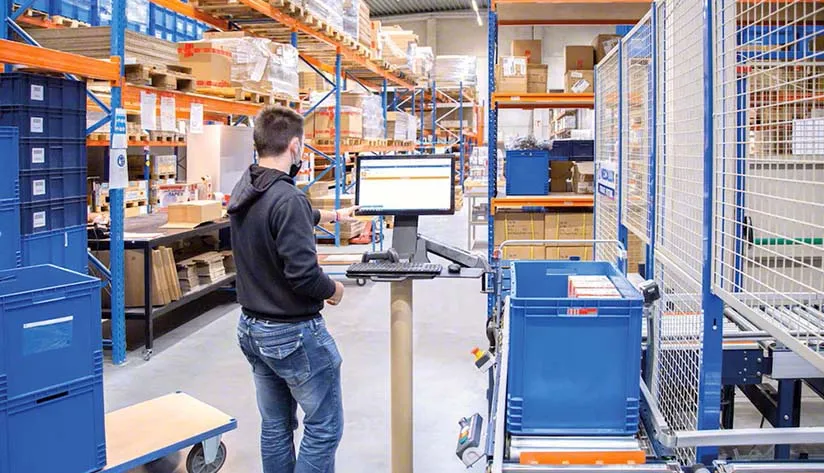
Integration with Existing Systems
Successful RFID implementation depends on its compatibility with your company’s current software systems, such as:
ERP (Enterprise Resource Planning Systems): Ensures RFID data can directly sync with platforms like SAP, Oracle, or Microsoft Dynamics, improving supply chain transparency.
WMS (Warehouse Management Systems): Facilitates automatic inventory updates, reducing manual errors and enhancing warehouse efficiency.
POS (Point of Sale Systems): In retail, RFID can streamline the checkout process with automatic transaction processing.
Access Control Systems: Ensures RFID cards or tags are compatible with existing security systems, enhancing safety and management.
Key Points:
- ✔ Look for RFID systems that support APIs or standard protocols (like RESTful API or SOAP) for easier integration with existing software.
- ✔ Ensure RFID hardware supports common data formats (like CSV, JSON, XML) for smooth data exchange.
- ✔ Consult with us before purchasing to verify compatibility with your business system.
Data Management & Analytics
Robust data management features are essential for the effective operation of an RFID system. The right software can provide:
Real-time Data Tracking: Monitors the movement of RFID tags to provide clear visibility of asset locations.
Data Analysis and Visualization: Generates reports on inventory, supply chain efficiency, or access usage to help managers make informed decisions.
Automated Alerts: Sends notifications when inventory levels are low or when equipment malfunctions occur.
Key Points:
- ✔ Choose software that supports cloud management for easy remote data access.
- ✔ Ensure the system offers customizable reports and dashboards for business performance analysis.
- ✔ Prioritize data security by ensuring RFID data is transmitted securely, preventing information leaks.
Scalability
As your business grows, your RFID system needs to adapt to increasing demands.
Flexible Expansion: Opt for systems that allow you to add more readers, antennas, and tags as your business expands.
Modular Design: Select modular RFID platforms that allow for future upgrades or equipment replacement without requiring a complete system overhaul.
Cloud Support: Look for cloud-managed RFID solutions that can easily scale across multiple sites.
Key Points:
- ✔ Choose RFID software that supports multi-site management to meet expanding business needs.
- ✔ Ensure the system can accommodate new hardware to avoid high future replacement costs.
- ✔ Look for software that supports automated updates to keep systems current and efficient.
In conclusion, selecting the right RFID hardware is crucial for maximizing the benefits of RFID technology. By ensuring the correct combination of tags, readers, and antennas, businesses can streamline operations, enhance efficiency, and reduce costs. By following the considerations outlined in this guide, you can ensure your RFID system meets your operational needs and provides long-term value.
FAQs
1. Can RFID technology work in extreme environments?**
Yes, but you need to select RFID tags and readers specifically designed for harsh conditions. It’s crucial to choose robust tags with appropriate IP ratings for waterproofing, dust resistance, and other protective features.
2. How does RFID improve inventory management efficiency?**
RFID automates inventory tracking by providing real-time data, which helps increase inventory accuracy and reduces theft as well as human errors.
3. What is the typical lifespan of RFID tags?**
The lifespan of RFID tags varies by type. Passive tags can last for several years, while active tags usually require battery replacements every 3 to 5 years.
4. Is it easy to integrate RFID systems with existing business operations?**
Yes, RFID systems can integrate with existing business operations, especially if you choose software that supports integration with your current systems, like inventory management or ERP systems.
Recommended Products
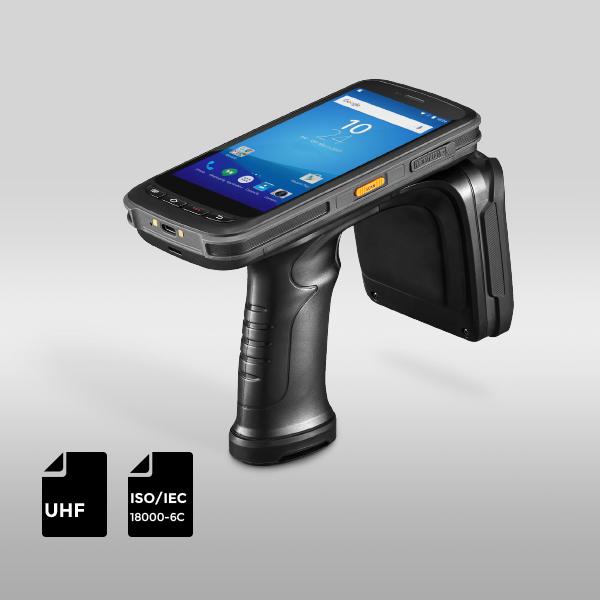
UHF RFID Handheld Reader | ISO 18000-6C
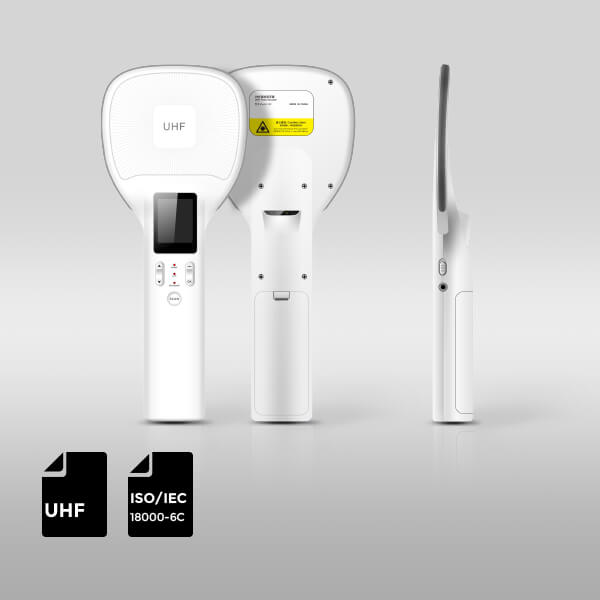

RFID Antenna UHF
15-Meter Cable for UHF RFID Fixed Reader
UHF Tag
4″x2″ 860-960MHz UHF RFID Label RFID M4D
UHF Tag
4″x4″UHF RFID Label Alien H3 | ISO18000-6C
RFID Antenna UHF
5-Meter Cable for UHF RFID Fixed Reader
HF Card
ABS RFID KEY-FOB Tag RFID Classic 1K
HF Card
ABS RFID KEY-FOB Tag RFID Classic 4K
HF Card
ABS RFID KEY-FOB Tag RFID Ultralight C
HF Tag
ABS RFID KEY-FOB Tag RFID Ultralight EV1
LF Card
ABS RFID KEY-FOB Tag ATA5577
LF Card
ABS RFID KEY-FOB Tag EM4200
HF Card
ABS RFID KEY-FOB Tag EM4305
HF Card
ABS RFID KEY-FOB Tag RFID TAG 213